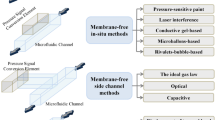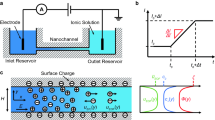Abstract
This study presents a new Y-channel design for measuring the zeta potential and surface conductance of a solid-liquid pairing using the current monitoring technique. The new design improves the throughput and reliability of the testing apparatus since the displacement between two solutions can be repeated many times without interfering with the experiments. It also increases the accuracy of the measurement by producing sharper start and end transitions for the current–time plot of the solution displacement process. In this design, efforts have been made to minimize the effects of electrolysis, Joule heating and undesired pressure driven flow on the measurements. An improvement on the current–time slope analysis is also presented. The Y-channel design was validated by comparing zeta potential measurements to published results. The zeta potential of several biological buffers relevant to the microfluidic community in plasma treated PDMS/PDMS and PDMS/Glass microchannels are presented. Preliminary studies of surface conductivity measurements using the Y-channel design were also conducted and are briefly discussed.







Similar content being viewed by others
References
Arulanandam S, Li DQ (2000) Determining zeta potential and surface conductance by monitoring the current in electro-osmotic flow. J Colloid Interface Sci 225:421–428
Beckwith TG, Marangoni RD, Lienhard JH (1993) Mechanical measurements, 5th edn. Prentice Hall
Bello MS (1996) Electrolytic modification of a buffer during a capillary electrophoresis run. J Chromatogr A 744:81–91
Bianchi F, Wagner F, Hoffmann P, Girault HH (2001) Electroosmotic flow in composite microchannels and implications in microcapillary electrophoresis systems. Anal Chem 73:829–836
Chen CH, Santiago JG (2002) A planar electroosmotic micropump. J Microelectromech Syst 11:672–683
Choi ES (2007) Improvement of electroosmotic flow characteristics in poly(dimethylsiloxane) channels via a long life chemical surface modification. In: 7th international conference on miniaturized chemical and biochemical analysis systems, 5–9 October 2007, CA, USA
Erickson D, Li DQ, Werner C (2000) An improved method of determining the zeta-potential and surface conductance. J Colloid Interface Sci 232:186–197
Fluri K, Fitzpatrick G, Chiem N, Harrison DJ (1996) Integrated capillary electrophoresis devices with an efficient postcolumn reactor in planar quartz and glass chips. Anal Chem 68:4285–4290
Gravesen P, Branebjerg J, Jensen OS (1993) Microfluidics—a review. J Micromech Microeng 3:168–182
Harrison DJ, Manz A, Fan ZH, Ludi H, Widmer HM (1992) Capillary electrophoresis and sample injection systems integrated on planar glass chip. Anal Chem 64:1926–1932
Hsieh SS, Lin HC, Lin CY (2006) Electroosmotic flow velocity measurements in a square microchannel. Colloid Polym Sci 284:1275–1286
Huang XH, Gordon MJ, Zare RN (1988) Current-monitoring method for measuring the electroosmotic flow rate in capillary zone electrophoresis. Anal Chem 60:1837–1838
Kirby BJ, Hasselbrink EF (2004a) Zeta potential of microfluidic substrates: 1. Theory, experimental techniques and effects on separations 25:187–202
Kirby BJ, Hasselbrink EF (2004b) Zeta potential of microfluidic substrates: 2. Data for polymers. 25:203–213
Macka M, Andersson P, Haddad PR (1998) Changes in electrolyte pH due to electrolysis during capillary zone electrophoresis. Anal Chem 70:743–749
Masliyah J, Bhattacharjee S (2006) Electrokinetic and colloid transport phenomena, Wiley
Pittman JL, Henry CS, Gilman SD (2003) Experimental studies of electroosmotic flow dynamics in microfabricated devices during current monitoring experiments. Anal Chem 75:361–370
Ren XQ, Bachman M, Sims C, Li GP, Allbritton N (2001) Electroosmotic properties of microfluidic channels composed of poly(dimethylsiloxane). J Chromatogr B 762:117–125
Ren LQ, Escobedo-Canseco C, Li DQ (2002) A new method of evaluating the average electro-osmotic velocity in microchannels. J Colloid Interface Sci 250:238–242
Rodriguez I, Chandrasekhar N (2005) Experimental study and numerical estimation of current changes in electroosmotically pumped microfluidic devices. Electrophoresis 26:1114–1121
Scales PJ, Grieser F, Healy TW, White LR, Chan DYC (1992) Eelectrokinetics of the silica solution interface—a flat-plate streaming potential study. Langmuir 8:965–974
Sinton D, Escobedo-Canseco C, Ren LQ, Li DQ (2002) Direct and indirect electroosmotic flow velocity measurements in microchannels. J Colloid Interface Sci 254:184–189
Sun Y, Lim CS, Liu AQ, Ayi TC, Yap PH (2007) Design simulation and experiment of electroosmotic microfluidic chip for cell sorting. 133:340–348
Sze A, Erickson D, Ren LQ, Li DQ (2003) Zeta-potential measurement using the Smoluchowski equation and the slope of the current-time relationship in electroosmotic flow. J Colloid Interface Sci 261:402–410
Tang G, Yan D, Yang C, Gong H, Chai C, Lam Y (2007) Joule heating and its effects on electrokinetic transport of solutes in rectangular microchannels. Sens Actuators A 139:221–232
Venditti R, Xuan XC, Li DQ (2006) Experimental characterization of the temperature dependence of zeta potential and its effect on electroosmotic flow velocity in microchannels. Microfluid Nanofluid 2:493–499
Xuan X (2008) Joule heating in electrokinetic flow. Electrophoresis 29:33–43
Yan DG, Yang C, Nguyen NT, Huang XY (2006) A method for simultaneously determining the zeta potentials of the channel surface and the tracer particles using microparticle image velocimetry technique. Electrophoresis 27:620–627
Yan DG, Yang C, Huang XY (2007) Effect of finite reservoir size on electroosmotic flow in microchannels. Microfluid Nanofluid 3:333–340
Zhang JB, He GW, Liu F (2006) Electro-osmotic flow and mixing in heterogeneous microchannels. Phys Rev E 73:056305
Acknowledgments
The authors gratefully acknowledge the support of research grants of the Natural Sciences and Engineering Research Council (NSERC) of Canada to C. L. Ren and D. A. Johnson, the Department of Mechanical Engineering at King Saud University for sponsoring Zeyad Almutairi and Ontario Graduate Scholarship and Canada Graduate Scholarship to Tomasz Glawdel. Zeyad Almutairi and Tomasz Glawdel made equally contributions to this study.
Author information
Authors and Affiliations
Corresponding author
Rights and permissions
About this article
Cite this article
Almutairi, Z.A., Glawdel, T., Ren, C.L. et al. A Y-channel design for improving zeta potential and surface conductivity measurements using the current monitoring method. Microfluid Nanofluid 6, 241–251 (2009). https://doi.org/10.1007/s10404-008-0320-6
Received:
Accepted:
Published:
Issue Date:
DOI: https://doi.org/10.1007/s10404-008-0320-6




